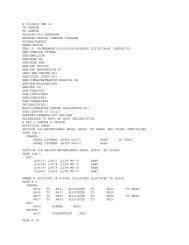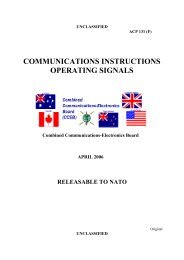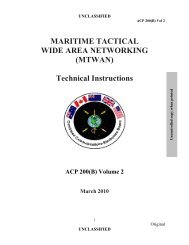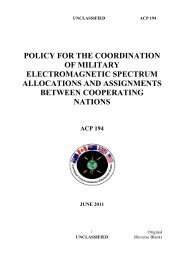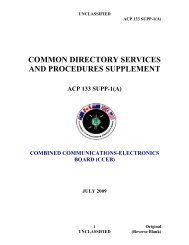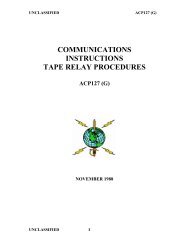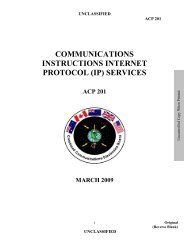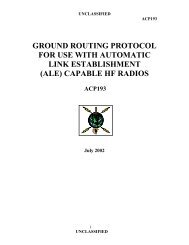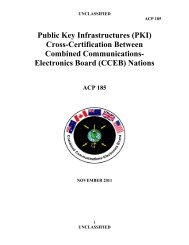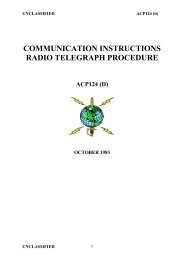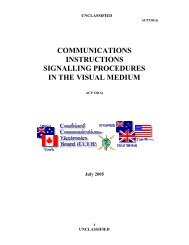- Page 1 and 2: UNCLASSIFIEDACP 200(B) Vol 1MARITIM
- Page 3 and 4: UNCLASSIFIEDACP 200(B) Vol 1THE COM
- Page 5 and 6: UNCLASSIFIEDACP 200(B) Vol 1TABLE O
- Page 7 and 8: UNCLASSIFIEDviiACP 200(B) Vol 1OVER
- Page 9 and 10: UNCLASSIFIEDLIST OF FIGURESFigure 1
- Page 11 and 12: UNCLASSIFIEDCHAPTER 1ACP 200(B) Vol
- Page 13 and 14: UNCLASSIFIEDACP 200(B) Vol 1likely
- Page 15 and 16: UNCLASSIFIEDACP 200(B) Vol 1CHAPTER
- Page 17 and 18: UNCLASSIFIEDACP 200(B) Vol 1209. Bo
- Page 19: UNCLASSIFIEDACP 200(B) Vol 1subnets
- Page 23 and 24: UNCLASSIFIEDACP 200(B) Vol 1OtherWA
- Page 25 and 26: UNCLASSIFIEDACP 200(B) Vol 1Applica
- Page 27 and 28: UNCLASSIFIEDACP 200(B) Vol 1Other A
- Page 29 and 30: UNCLASSIFIEDACP 200(B) Vol 1executi
- Page 31 and 32: UNCLASSIFIEDACP 200(B) Vol 1Timelin
- Page 33 and 34: UNCLASSIFIEDACP 200(B) Vol 1e. Info
- Page 35 and 36: UNCLASSIFIEDACP 200(B) Vol 1INFORMA
- Page 37 and 38: UNCLASSIFIEDACP 200(B) Vol 1rate be
- Page 39 and 40: UNCLASSIFIEDACP 200(B) Vol 1INFORMA
- Page 41 and 42: UNCLASSIFIEDACP 200(B) Vol 1MESSAGE
- Page 43 and 44: UNCLASSIFIEDACP 200(B) Vol 1334. Th
- Page 45 and 46: UNCLASSIFIEDACP 200(B) Vol 1LINE US
- Page 47 and 48: UNCLASSIFIEDACP 200(B) Vol 1LINE US
- Page 49 and 50: UNCLASSIFIEDACP 200(B) Vol 1LINE US
- Page 51 and 52: UNCLASSIFIEDACP 200(B) Vol 1GENTEXT
- Page 53 and 54: INTRODUCTIONUNCLASSIFIEDFILE COMPRE
- Page 55 and 56: UNCLASSIFIEDACP 200(B) Vol1when dec
- Page 57 and 58: UNCLASSIFIEDMS POWERPOINTANNEX D TO
- Page 59 and 60: UNCLASSIFIEDACP 200(B) Vol1a. Lower
- Page 61 and 62: UNCLASSIFIEDACP 200(B) Vol 1CHAPTER
- Page 63 and 64: UNCLASSIFIEDACP 200(B) Vol 1407. Fu
- Page 65 and 66: UNCLASSIFIEDACP 200(B) Vol 1419. St
- Page 67 and 68: UNCLASSIFIEDACP 200(B) Vol 1BPDCOAL
- Page 69 and 70: UNCLASSIFIEDACP 200(B) Vol 1Figure
- Page 71 and 72:
UNCLASSIFIEDACP 200(B) Vol 1ACCREDI
- Page 73 and 74:
UNCLASSIFIEDACP 200(B) Vol 1WAN LIN
- Page 75 and 76:
UNCLASSIFIEDACP 200(B) Vol 1CHAPTER
- Page 77 and 78:
UNCLASSIFIEDACP 200(B) Vol 1E-MAILa
- Page 79 and 80:
UNCLASSIFIEDACP 200(B) Vol 1Informa
- Page 81 and 82:
UNCLASSIFIEDACP 200(B) Vol 1626. Th
- Page 83 and 84:
UNCLASSIFIEDACP 200(B) Vol 1CHAPTER
- Page 85 and 86:
UNCLASSIFIEDACP 200(B) Vol 1FOTC711
- Page 87 and 88:
UNCLASSIFIEDACP 200(B) Vol 1Figure
- Page 89 and 90:
UNCLASSIFIEDACP 200(B) Vol1ANNEX A
- Page 91 and 92:
UNCLASSIFIEDACP 200(B) Vol1understa
- Page 93 and 94:
UNCLASSIFIEDACP 200(B) Vol1Tier 1 J
- Page 95 and 96:
UNCLASSIFIEDACP 200(B) Vol1Tier 2 J
- Page 97 and 98:
UNCLASSIFIEDACP 200(B) Vol1Compatib
- Page 99 and 100:
UNCLASSIFIEDACP 200(B) Vol1Tier 2 J
- Page 101 and 102:
UNCLASSIFIEDACP 200 (B) Vol 1a. Web
- Page 103 and 104:
UNCLASSIFIEDACP 200 (B) Vol 1WEB AD
- Page 105 and 106:
UNCLASSIFIEDACP 200 (B) Vol 1CONNEC
- Page 107 and 108:
UNCLASSIFIEDACP 200 (B) Vol 1WEB PA
- Page 109 and 110:
UNCLASSIFIEDACP 200 (B) Vol 1CONCLU
- Page 111 and 112:
UNCLASSIFIEDACP 200(B) Vol 1HUB SPO
- Page 113 and 114:
UNCLASSIFIEDACP 200(B) Vol 110. The
- Page 115 and 116:
UNCLASSIFIEDACP 200(B) Vol 1NETWORK
- Page 117 and 118:
UNCLASSIFIEDACP 200(B) Vol 1PAGE-LE
- Page 119 and 120:
UNCLASSIFIEDANNEX C TOCHAPTER 8 TOA
- Page 121 and 122:
UNCLASSIFIEDACP 200(B) Vol 1BENEFIT
- Page 123 and 124:
UNCLASSIFIEDACP 200(B) Vol 1sensiti
- Page 125 and 126:
UNCLASSIFIEDACP 200(B) Vol 1INTRODU
- Page 127 and 128:
UNCLASSIFIEDACP 200(B) Vol 1DELIBER
- Page 129 and 130:
UNCLASSIFIEDACP 200(B) Vol 1of thes
- Page 131 and 132:
UNCLASSIFIEDACP 200(B) Vol 1BANDWID
- Page 133 and 134:
UNCLASSIFIEDACP 200(B) Vol 1a. Inte
- Page 135 and 136:
UNCLASSIFIEDANNEX B TOCHAPTER 8 TOA
- Page 137 and 138:
UNCLASSIFIEDACP 200(B) Vol 17. Tabl
- Page 139 and 140:
UNCLASSIFIEDACP 200(B) Vol 1LargePE
- Page 141 and 142:
UNCLASSIFIEDACP 200(B) Vol 1ESTABLI
- Page 143 and 144:
UNCLASSIFIEDACP 200(B) Vol 1INADVER
- Page 145 and 146:
UNCLASSIFIEDACP 200(B)ANNEX C TOCHA
- Page 147 and 148:
UNCLASSIFIEDACP 200(B)Tool Characte
- Page 149 and 150:
UNCLASSIFIEDACP 200(B)Tool Characte
- Page 151 and 152:
UNCLASSIFIEDACP 200(B)Tool Characte
- Page 153 and 154:
UNCLASSIFIEDACP 200(B) Vol 1ACRONYM
- Page 155 and 156:
UNCLASSIFIEDACP 200(B) Vol 1EMCONEo
- Page 157 and 158:
UNCLASSIFIEDACP 200(B) Vol 1NBARNet
- Page 159 and 160:
UNCLASSIFIEDLIST OF EFFECTIVE PAGES



